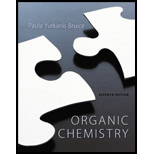
(a)
Interpretation:
Nucleophile which forms the given compounds when it reacts with
Concept Introduction:
The SN2 reaction is a type of reaction mechanism in which one bond is broken and one bond is formed i.e., in one step. SN2 is a kind of nucleophilic substitution reaction mechanism.
The nucleophile attacks the back side of the carbon that is attached to the halogen. Therefore it takes an inversion of configuration.
The configuration of the product is inverted relative to the configuration of the reactant.
(b)
Interpretation:
Nucleophile which forms given compounds when it reacts with
Concept Introduction:
The SN2 reaction is a type of reaction mechanism in which one bond is broken and one bond is formed i.e., in one step. SN2 is a kind of nucleophilic substitution reaction mechanism.
Steric effect is the effect due to the groups occupies a certain volume of space.
Steric hindrance is caused by the bulky groups at the site of a reaction that makes it difficult for the reactants to approach each other.
(c)
Interpretation:
Nucleophile which forms given compounds when it reacts with
Concept Introduction:
The SN2 reaction is a type of reaction mechanism in which one bond is broken and one bond is formed i.e., in one step. SN2 is a kind of nucleophilic substitution reaction mechanism.
Aprotic solvent are polar solvent molecules which do not have hydrogen bonded to oxygen to nitrogen.
Protic solvent are polar solvent molecules which do have hydrogen bonded to oxygen to nitrogen.
The stronger base is always a better nucleophile in an aprotic solvent.
(d)
Interpretation:
Nucleophile which forms the following compounds when it reacts with
Concept Introduction:
The SN2 reaction is a type of reaction mechanism in which one bond is broken and one bond is formed i.e., in one step. SN2 is a kind of nucleophilic substitution reaction mechanism.
The stronger base is always a better nucleophile in an aprotic solvent.
(e)
Interpretation:
Nucleophile which forms the following compounds when it reacts with
Concept Introduction:
The SN2 reaction is a type of reaction mechanism in which one bond is broken and one bond is formed i.e., in one step. SN2 is a kind of nucleophilic substitution reaction mechanism.
The nucleophile attacks the back side of the carbon that is attached to the halogen. Therefore it takes an inversion of configuration.
The configuration of the product is inverted relative to the configuration of the reactant.
(f)
Interpretation:
Nucleophile which forms given compounds when it reacts with
Concept Introduction:
The SN2 reaction is a type of reaction mechanism in which one bond is broken and one bond is formed i.e., in one step. SN2 is a kind of nucleophilic substitution reaction mechanism. The nucleophile attacks the back side of the carbon that is attached to the halogen. Therefore it takes an inversion of configuration.
The configuration of the product is inverted relative to the configuration of the reactant.
(g)
Interpretation:
Nucleophile which forms given compound when it reacts with
Concept Introduction:
The SN2 reaction is a type of reaction mechanism in which one bond is broken and one bond is formed i.e., in one step. SN2 is a kind of nucleophilic substitution reaction mechanism.
The nucleophile attacks the back side of the carbon that is attached to the halogen. Therefore it takes an inversion of configuration.
The configuration of the product is inverted relative to the configuration of the reactant.
(h)
Interpretation:
Nucleophile which forms given compound when it reacts with
Concept Introduction:
The SN2 reaction is a type of reaction mechanism in which one bond is broken and one bond is formed i.e., in one step. SN2 is a kind of nucleophilic substitution reaction mechanism.
The nucleophile attacks the back side of the carbon that is attached to the halogen. Therefore it takes an inversion of configuration.
The configuration of the product is inverted relative to the configuration of the reactant.
Trending nowThis is a popular solution!

Chapter 9 Solutions
Organic Chemistry; Modified MasteringChemistry with Pearson eText -- ValuePack Access Card; Study Guide and Student Solutions Manual for Organic Chemistry, Books a la Carte Edition (7th Edition)
- Rank the following compounds in order of increasing reactivity during an electrophilic substitution reactionarrow_forwardWhich benzene derivative would be the most reactive in an electrophilic aromatic substitution reaction? NO2arrow_forwardPleas explain how this process occurs. Identify SN1, SN2, E2, E1, nucleophiles and electrophiles.arrow_forward
- How many elimination products will be formed in the following reaction?arrow_forwardThe reaction of 1-bromobutane with which of the following nucleophiles is a carbon chain-lengthening reaction? sodium acetylide (NaC=CH) sodium hydroxide (NaOH) O ammonia (NH3) potassium iodide (KI)arrow_forward9. Which of the following nucleophiles can undergo a substitution reaction with an alcohol under strongly acidic conditions? NH₂ - A B Br C D MgBrarrow_forward
- Which of the following compounds is most reactive towards nucleophilic addition reactions?arrow_forwardRank the following esters from most reactive to least reactive in the first slow step of a nucleophilic acyl substitution reaction (formation of the tetrahedral intermediate): Rank the same esters from most reactive to least reactive in the second slow step of a nucleophilic acyl substitution reaction (collapse of the tetrahedral intermediate).arrow_forwardWhat products are formed when the following compound reacts with ozone and then with dimethyl sulfide?arrow_forward
- What will be the resulting products structure when oxacyclopentane reacts with concentrated HBr?arrow_forwardWhat products are formed when the following compounds react with ozone and then with dimethyl sulfide?arrow_forward5. What is the structure of an intermediate in the methyl shift rearrangement reaction shown in the box? A) C) B H₂SO4, H₂O B) D) OHarrow_forward
 Organic ChemistryChemistryISBN:9781305580350Author:William H. Brown, Brent L. Iverson, Eric Anslyn, Christopher S. FootePublisher:Cengage Learning
Organic ChemistryChemistryISBN:9781305580350Author:William H. Brown, Brent L. Iverson, Eric Anslyn, Christopher S. FootePublisher:Cengage Learning

